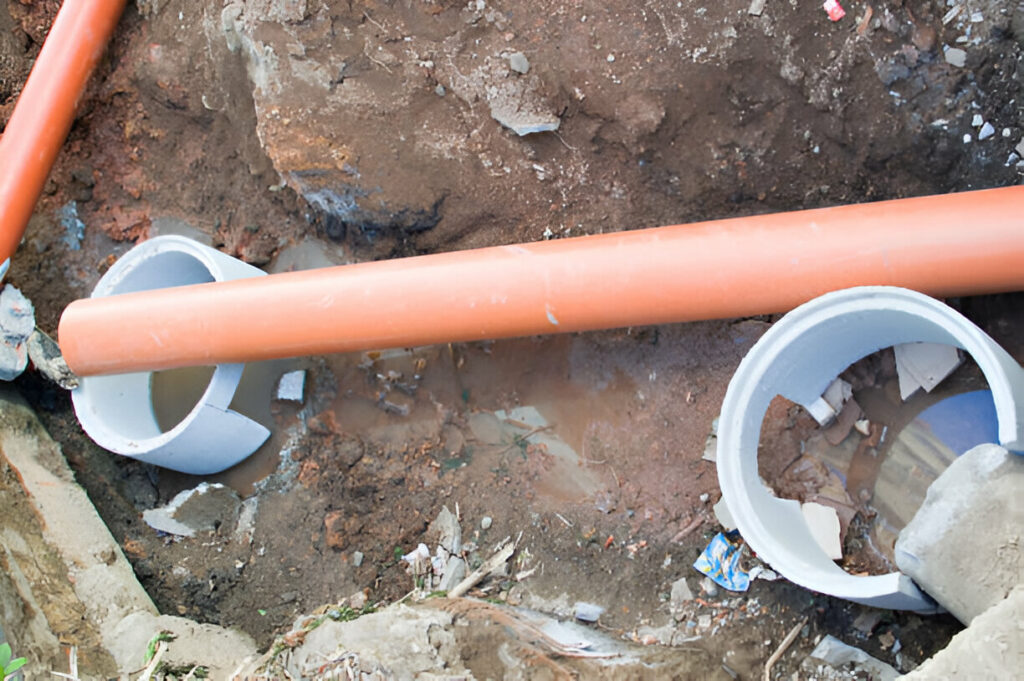What’s worse than a clogged drain? A collapsed drain pipe! Dealing with this issue can be a homeowner’s nightmare. But don’t worry, we’re here to help you navigate this messy situation. Understanding what a collapsed drain pipe is and how to address it can save you time, money, and a lot of headaches.
Causes of a Collapsed Drain Pipe
Natural Wear and Tear
Over time, even the most robust pipes can succumb to wear and tear. Factors like water pressure and the type of material used for the pipes play significant roles in their longevity.
Tree Root Intrusion
Trees are wonderful for your yard but not so much for your underground pipes. Roots naturally seek out water and can infiltrate your pipes, causing them to crack and eventually collapse.
Heavy Traffic and Soil Movement
Heavy vehicles driving over the ground above your pipes or natural soil movement from things like erosion or earthquakes can cause pipes to shift and break.
Poor Installation Practices
If your pipes were not installed correctly from the start, they’re more likely to collapse. This can include incorrect bedding or inadequate jointing of the pipes.
Signs of a Collapsed Drain Pipe
Slow Drainage
One of the first signs of trouble is water draining slower than usual. If you notice this in multiple fixtures, it’s a red flag.
Gurgling Sounds in Pipes
Strange gurgling noises from your drains can indicate air being trapped due to a blockage or collapse.
Frequent Clogs and Backups
If you’re constantly dealing with clogs and backups, the problem might be deeper in your system.
Unpleasant Odors
Bad smells coming from your drains can indicate a break where sewage is leaking.
Immediate Steps to Take When You Suspect a Collapsed Drain Pipe
Stop Using the Affected Drain
To prevent further damage or mess, stop using the drains in the affected area immediately.
Call a Professional Plumber
This isn’t a DIY situation. Get a professional plumber on the scene as soon as possible.
Inspection and Diagnosis
Camera Inspection
Professionals often use a small camera to inspect the inside of your pipes. This helps pinpoint the exact location and cause of the collapse.
Physical Inspection by a Professional
Sometimes a hands-on approach is necessary, especially if the damage is extensive or complicated.
Repair Options for a Collapsed Drain Pipe
Trenchless Pipe Repair
Pipe Relining
This involves inserting a flexible tube coated with resin into the damaged pipe. The tube is inflated and the resin hardens, creating a new pipe within the old one.
Pipe Bursting
A new pipe is pulled through the old one, breaking the original pipe apart and replacing it simultaneously.
Traditional Excavation Methods
Sometimes, the old-fashioned way is the best. Digging up and replacing the damaged section of pipe can be necessary for severe cases.
Trenchless Pipe Repair: Advantages and Disadvantages
Pros of Trenchless Repair
- Less Disruptive: Minimal digging required, preserving your landscape.
- Faster Completion: Often completed in a day.
- Cost-Effective: Reduced labor and restoration costs.
Cons of Trenchless Repair
- Not Always Possible: Not suitable for all types of damage.
- Cost: Initial costs can be high, depending on the extent of the damage.
Traditional Excavation Methods: Advantages and Disadvantages
Pros of Traditional Excavation
- Versatility: Suitable for any type of pipe and damage.
- Thorough: Complete replacement of damaged sections.
Cons of Traditional Excavation
- Disruptive: Significant digging can ruin landscapes and structures.
- Time-Consuming: Takes longer to complete compared to trenchless methods.
Preventive Measures to Avoid Future Pipe Collapses
Regular Maintenance
Schedule regular inspections and cleanings to catch issues before they become major problems.
Monitoring Tree Growth
Keep an eye on trees near your pipes. Consider root barriers or removing problematic trees.
Proper Installation Techniques
Ensure that any new pipes are installed by professionals using the correct methods.
Costs Involved in Repairing a Collapsed Drain Pipe
Cost of Trenchless Repair
This can range from $80 to $250 per foot, depending on the complexity and location of the repair.
Cost of Traditional Excavation
Expect to pay between $50 and $200 per foot, plus the cost of restoring your landscape.
How to Choose the Right Repair Method
Factors to Consider
Consider the extent of the damage, location of the pipes, and budget.
Consulting with a Professional
A professional plumber can provide advice tailored to your specific situation.
DIY vs. Professional Repair
Risks of DIY Repair
Without the proper knowledge and tools, you could make the problem worse or even dangerous.
Benefits of Hiring a Professional
Professionals have the expertise and equipment to get the job done right the first time.
Case Studies: Successful Collapsed Pipe Repairs
Residential Repair Stories
One homeowner discovered a collapsed pipe due to tree roots and opted for trenchless repair, which saved their beautiful garden.
Commercial Repair Stories
A commercial building faced severe pipe collapse. Traditional excavation was chosen due to the pipe’s extensive damage, ensuring a thorough repair.
Environmental Impact of Different Repair Methods
Eco-Friendly Repair Options
Trenchless repairs are typically more environmentally friendly, as they reduce the need for extensive digging.
Long-Term Environmental Considerations
Choosing durable materials and methods ensures fewer repairs and replacements, benefiting the environment in the long run.
FAQs
How long does a trenchless repair last?
Trenchless repairs can last 50 years or more, depending on the materials used and the quality of the installation.
Can a collapsed drain pipe be prevented?
Yes, with regular maintenance, monitoring for tree root intrusion, and proper installation techniques, you can prevent most cases of collapsed drain pipes.
What is the quickest way to fix a collapsed drain pipe?
Trenchless repair methods are typically the quickest, often completed within a day.
How do I know if my drain pipe is collapsed or just clogged?
Frequent clogs, slow drainage, and unpleasant odors are signs of a more serious issue like a collapse. A professional inspection can provide a definitive answer.
Is it safe to use chemical drain cleaners on a collapsed drain pipe?
No, chemical drain cleaners can exacerbate the problem and damage the pipes further. It’s best to consult a professional plumber.
Conclusion!!
Dealing with a collapsed drain pipe is undoubtedly stressful, but understanding your options can make the process smoother. Whether you opt for trenchless repair or traditional excavation, the key is to act quickly and consult with a professional. Regular maintenance and being aware of the signs can prevent a small problem from becoming a major headache.







